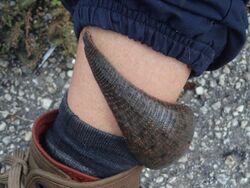Biology:Haementeria ghilianii
| Haementeria ghilianii | |
|---|---|

| |
| Scientific classification | |
| Domain: | Eukaryota |
| Kingdom: | Animalia |
| Phylum: | Annelida |
| Class: | Clitellata |
| Subclass: | Hirudinea |
| Order: | Rhynchobdellida |
| Family: | Glossiphoniidae |
| Genus: | Haementeria |
| Species: | H. ghilianii
|
| Binomial name | |
| Haementeria ghilianii de Filippi, 1849
| |
Haementeria ghilianii, (the Amazon giant leech) is one of the world's largest species of leeches.
Taxonomy and discovery
Haementeria ghilianii is a species of leech in the Glossiphoniidae family, comprising freshwater proboscis-bearing leeches. Colloquially, they are known as the Amazon giant leech. The species was declared extinct in 1893 after no wild specimen could be found.[1]
Rediscovery and colonization
In the 1970s, Dr. Roy Sawyer discovered two adult specimens in a pond located in French Guiana. One of these leeches, dubbed Grandma Moses, founded a successful breeding colony at UC Berkeley. This specimen produced 750 offspring.[1] Following Grandma Moses' death, the specimen was placed in the Smithsonian's National Invertebrate Collection.[2]
Description
Haementeria ghilianii is a jawless, blood sucking leech. It can grow to 450 mm (17.7 in) in length and 100 mm (3.9 in) in width.[1] This makes it the largest freshwater leech known.[2] As adults, these leeches are a uniform greyish-brown color. Juveniles do not have a uniform color, but rather, a noncontinuous greyish-brown stripe and patches of color. The leeches form a "cobra hood" like shape that is widest in the center but tapers off on both ends.[1][2] The wider end is where the proboscis is located, while the head is at the narrow end; H. ghilianii is made up 34 segments, each with its own ganglia.[3]
Life cycle
This species is hermaphroditic; the male reproductive system is 3 g (0.0066 lb) to 5 g (0.011 lb) while the female reproductive system is 10 g (0.022 lb).[2][1] Growth is irregular, as the leech's body weight increases by 3 to 6 fold times per feeding. Fecundity is based upon the weight of the leech during oviposition; egg clutches range from 60 to 500 eggs.[4]
Behavior and ecology
When stressed, leeches will produce mucus to evade predators.[3]
Feeding
Unlike jawed leeches who use rows of teeth to puncture skin, Haementeria ghilianii uses a 10 centimetres (3.9 in) hypodermic needle style proboscis to feed. Bites are kept open by the fibrinogenolytic (breaks up fibrinogen) enzyme hementin, which is secreted from the proboscis' lumen; secretion is neurologically controlled. Hementin dissolves clots within the proboscis by breaking up the fibrinogen links between individual platelets. Once attached to a host, they release anticoagulants to prevent clotting, consuming blood at a rate of 0.14 ml to 15 ml per minute.[1][5] Blood is moved into the digestive system through a series of undulation movements, and leeches can go months without feeding.[3][5] Observed host species include humans, rabbits, and cows.[1][5] Claims from 1899 state that leeches could aggregate to the point of killing birds and cattle.[3]
Distribution
Haementeria ghilianii is endemic to the northern portions of the Amazon river, ranging from Venezuela and the Guianas.[1]
References
- ↑ 1.0 1.1 1.2 1.3 1.4 1.5 1.6 1.7 Steven Ryan (1 May 2015). "Amazon Giant Leech (Haementeria ghilianii)". https://blogs.unbc.ca/biol202/2015/05/01/amazon-giant-leech-haementeria-ghilianii/. Retrieved 14 October 2018. Article with photograph.
- ↑ 2.0 2.1 2.2 2.3 Magazine, Smithsonian; Gambino, Megan. "The List: 5 Weirdest Worms at the Smithsonian" (in en). https://www.smithsonianmag.com/smithsonian-institution/the-list-5-weirdest-worms-at-the-smithsonian-47017905/.
- ↑ 3.0 3.1 3.2 3.3 Taiwo, Victor (2022). "What Is the Largest Leech Ever Discovered?". https://a-z-animals.com/blog/what-is-the-largest-leech-ever-discovered/.
- ↑ Sawyer, Roy T.; Lepont, Francois; Stuart, Duncan K.; Kramer, Andrew P. (1981). "GROWTH AND REPRODUCTION OF THE GIANT GLOSSIPHONIID LEECH HAEMENTERIA GHILIANII" (in en). The Biological Bulletin 160 (2): 322–331. doi:10.2307/1540892. ISSN 0006-3185. https://www.journals.uchicago.edu/doi/10.2307/1540892.
- ↑ 5.0 5.1 5.2 Sawyer, R. T.; Jones, C. P.; Munro, R. (1991). "The biological function of hementin in the proboscis of the leech Haementeria ghilianii". Blood Coagulation & Fibrinolysis: An International Journal in Haemostasis and Thrombosis 2 (1): 153–159. doi:10.1097/00001721-199102000-00023. ISSN 0957-5235. PMID 1772983. https://pubmed.ncbi.nlm.nih.gov/1772983/.
Wikidata ☰ Q4040334 entry
 |

